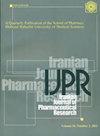纳米二氧化硅颗粒诱导雄性大鼠肾脏纤维化和氧化应激及其分子机制
IF 1.8
4区 医学
Q3 PHARMACOLOGY & PHARMACY
引用次数: 0
摘要
背景:无定形二氧化硅纳米粒子(SiNPs)在各种应用中越来越受欢迎,但它对人类和环境健康构成潜在风险。然而,SiNPs 引发肾损伤的根本原因和机制在很大程度上仍然未知。研究目的本研究旨在调查 SiNPs 诱导的肾脏损伤,并进一步探讨 SiNPs 诱导肾毒性的可能机制。研究方法将 30 只成年雄性大鼠分为 3 组。给第 2 组和第 3 组大鼠注射两种剂量水平(25 毫克/千克体重和 100 毫克/千克体重)的 SiNPs,而对照组大鼠在 28 天内不接受任何治疗。分析了肾组织中的活性氧(ROS)、抗氧化酶活性(谷胱甘肽过氧化物酶 [GPx]、超氧化物歧化酶 [SOD] 和过氧化氢酶 [CAT])、谷胱甘肽(GSH)水平和氧化标记物(如脂质过氧化 [丙二醛 (MDA)]和蛋白质氧化 [蛋白质羰基 (PCO)])。此外,还通过组织病理学检查和纤维化生物标志物的表达水平对肾脏纤维化进行了研究。结果:研究结果表明,在体内使用 SiNPs 会以剂量依赖的方式显著引发肾组织中的氧化应激。其特点是 ROS 生成增加,MDA、PCO 和一氧化氮(NO)水平升高,SOD、CAT、GPx 活性显著下降,GSH 减少。这些变化与组织病理学分析结果一致,即间质纤维化伴有单核炎症细胞聚集、肾小管变性、肾小球肾炎和肾小球萎缩。纤维化指数通过马森三色染色法得到证实。此外,纤维化相关基因,包括转化生长因子-β1(TGF-β1)、基质金属蛋白酶 2 和 9(MMP-2/9)的表达明显上调,而组织金属蛋白酶 2 抑制剂(TIMP2)的表达则出现下调。结论本研究为 ROS 和 TGF-β 信号通路失调在 SiNPs 肾毒性中的作用提供了新的研究线索。本文章由计算机程序翻译,如有差异,请以英文原文为准。
Renal Fibrosis and Oxidative Stress Induced by Silica Nanoparticles in Male Rats and Its Molecular Mechanisms
Background: The utilization of amorphous silica nanoparticles (SiNPs) is gaining popularity in various applications, but it poses a potential risk to human and environmental health. However, the underlying causes and mechanisms of SiNPs-induced kidney damage are still largely unknown. Objectives: This study aimed to investigate the SiNPs-induced damage in the kidney and further explore the possible mechanisms of SiNPs-induced nephrotoxicity. Methods: Thirty adult male rats were divided into 3 different groups. Rats in groups 2 and 3 were administered SiNPs at 2 dosage levels (25 and 100 mg/kg of body weight), while the rats in the control group received no treatment for 28 days. Reactive oxygen species (ROS), antioxidant enzyme activities (glutathione peroxidase [GPx], superoxide dismutase [SOD], and catalase [CAT]), glutathione (GSH) levels, and oxidation markers (such as lipid peroxidation [malondialdehyde (MDA)] and protein oxidation [protein carbonyl (PCO)]) were analyzed in the kidney tissue. Additionally, renal fibrogenesis was studied through histopathological examination and the expression levels of fibrotic biomarkers. Results: The findings revealed that in vivo treatment with SiNPs significantly triggered oxidative stress in kidney tissues in a dose-dependent manner. This was characterized by increased production of ROS, elevated levels of MDA, PCO, and nitric oxide (NO), along with a significant decline in the activities of SOD, CAT, GPx, and reduced GSH. These changes were consistent with the histopathological analysis, which indicated interstitial fibrosis with mononuclear inflammatory cell aggregation, tubular degeneration, glomerulonephritis, and glomerular atrophy. The fibrosis index was confirmed using Masson's trichrome staining. Additionally, there was a significant upregulation of fibrosis-related genes, including transforming growth factor-beta 1 (TGF-β1), matrix metalloproteinases 2 and 9 (MMP-2/9), whereas the expression of tissue inhibitor of metalloproteinase 2 (TIMP2) was downregulated. Conclusions: This study provided a new research clue for the role of ROS and deregulated TGF-β signaling pathway in SiNPs nephrotoxicity.
求助全文
通过发布文献求助,成功后即可免费获取论文全文。
去求助
来源期刊
CiteScore
3.40
自引率
6.20%
发文量
52
审稿时长
2 months
期刊介绍:
The Iranian Journal of Pharmaceutical Research (IJPR) is a peer-reviewed multi-disciplinary pharmaceutical publication, scheduled to appear quarterly and serve as a means for scientific information exchange in the international pharmaceutical forum. Specific scientific topics of interest to the journal include, but are not limited to: pharmaceutics, industrial pharmacy, pharmacognosy, toxicology, medicinal chemistry, novel analytical methods for drug characterization, computational and modeling approaches to drug design, bio-medical experience, clinical investigation, rational drug prescribing, pharmacoeconomics, biotechnology, nanotechnology, biopharmaceutics and physical pharmacy.

 求助内容:
求助内容: 应助结果提醒方式:
应助结果提醒方式:


